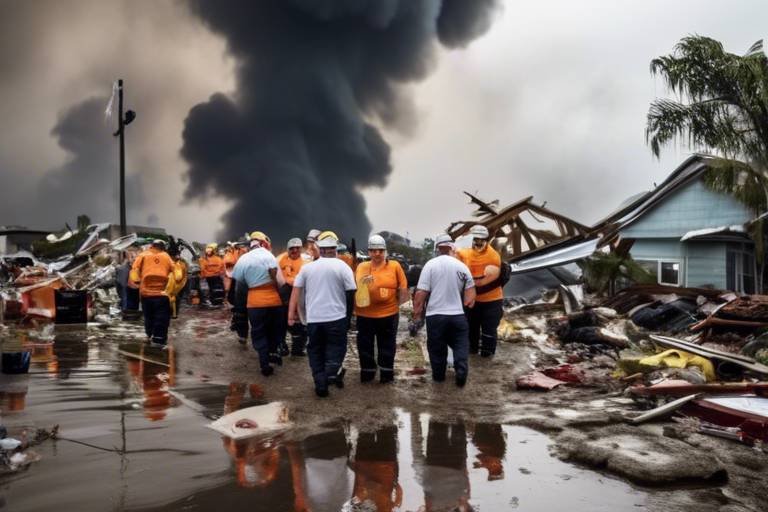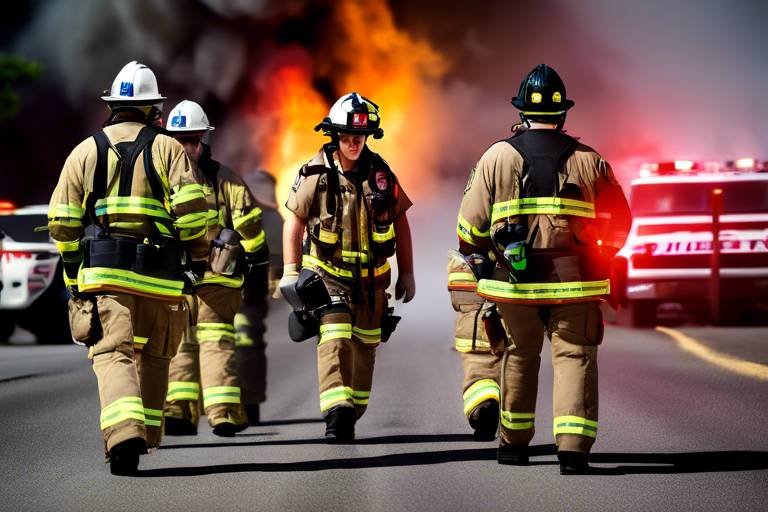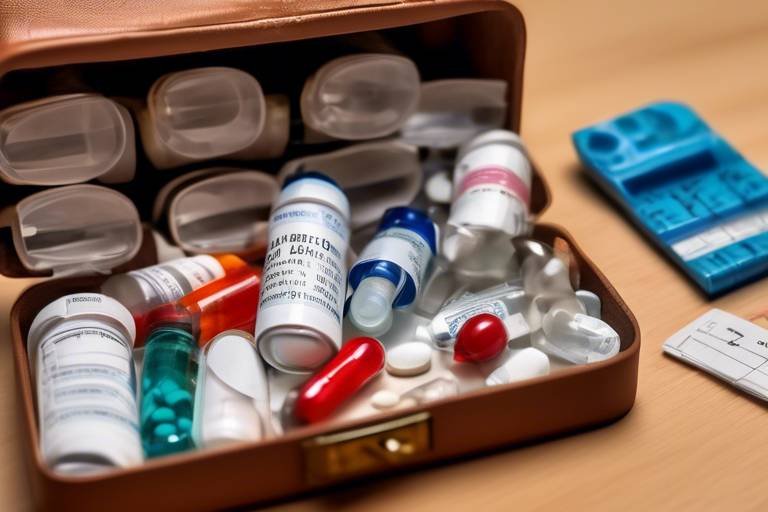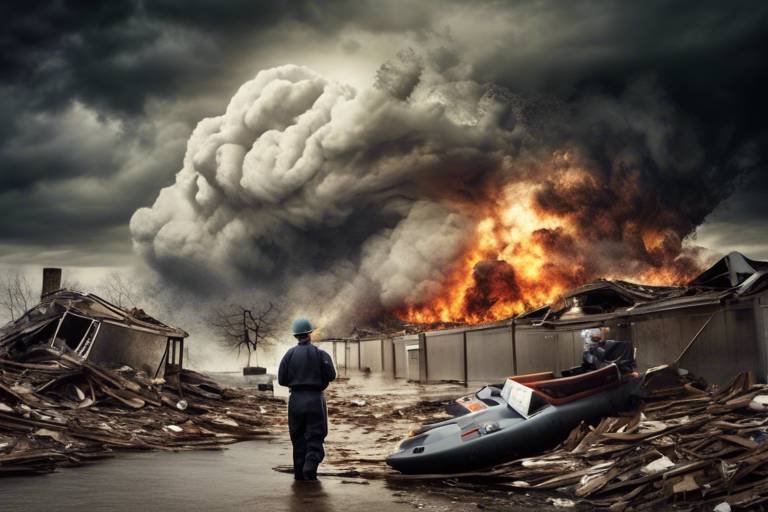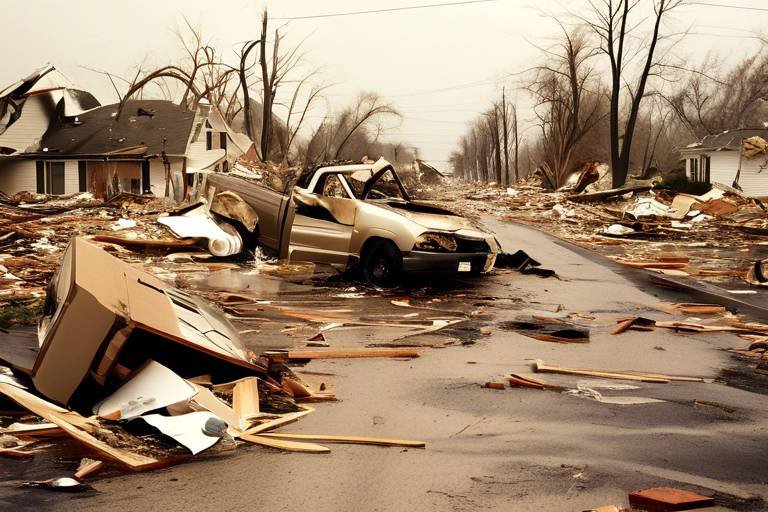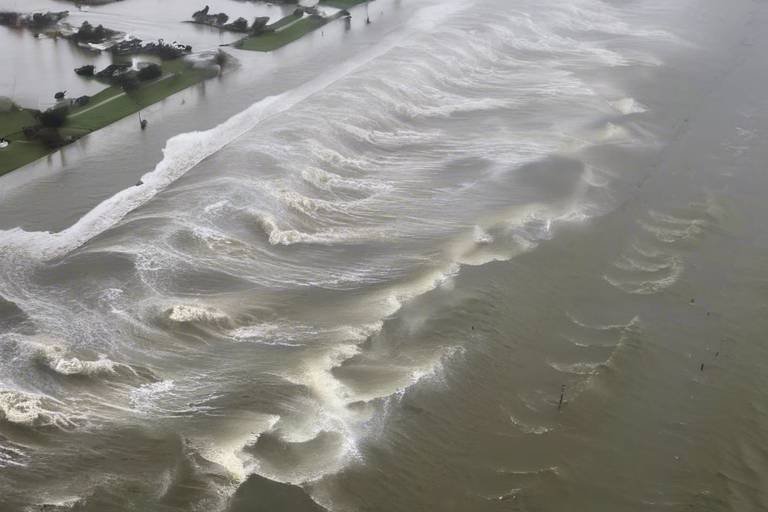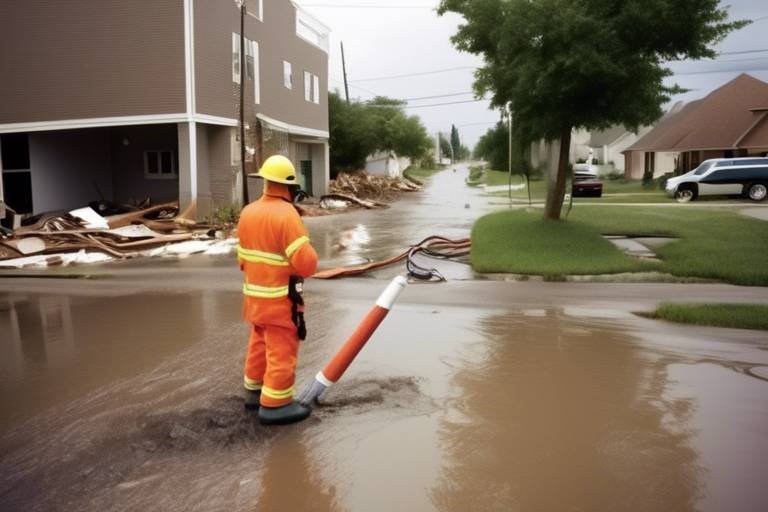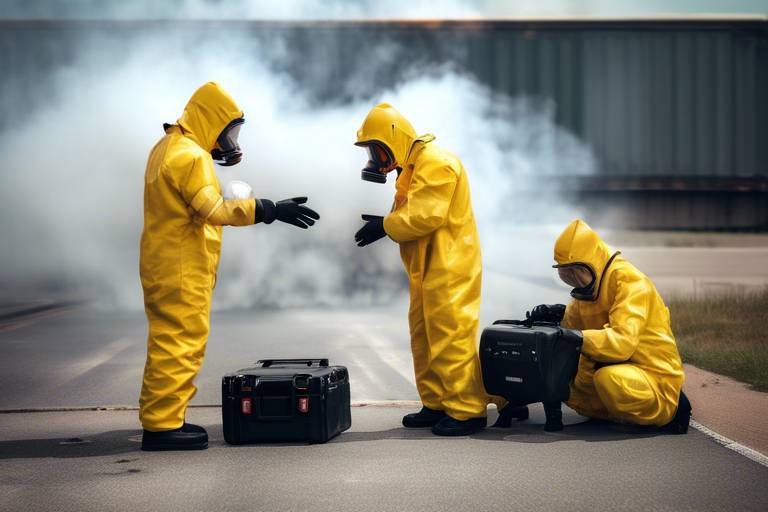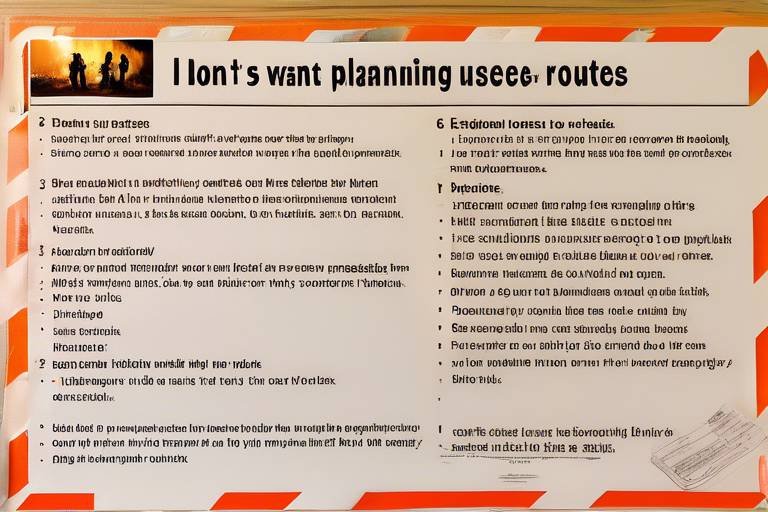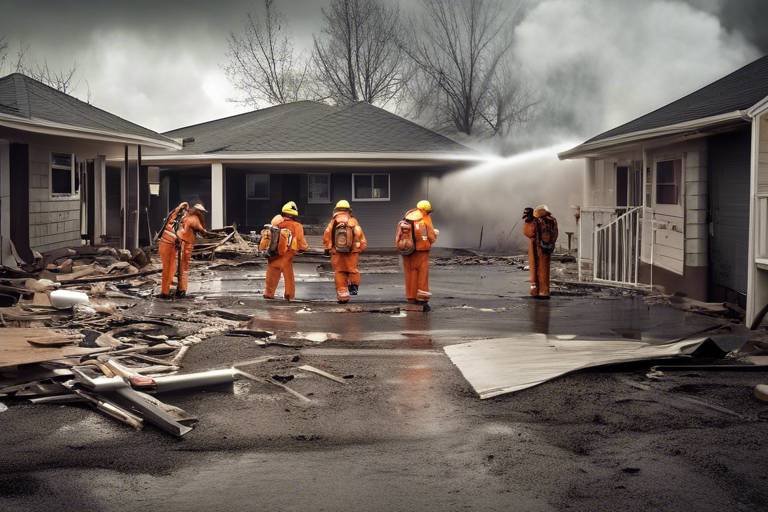Disaster Response – A Time to Show Unity and Strength
Disasters can strike at any moment, often leaving communities in a state of shock and despair. Whether it's a natural calamity like a hurricane or an unforeseen event such as an industrial accident, the aftermath can be devastating. However, in these challenging times, we often witness the **extraordinary power of unity and collective strength**. When individuals come together, they can create a formidable force capable of overcoming the most daunting obstacles. This article delves into the importance of collective action during disasters, emphasizing strategies for effective response, community resilience, and the pivotal role of governments and organizations in fostering unity in times of crisis.
Community resilience is not just a buzzword; it's a **critical component** in disaster response. Imagine a neighborhood where everyone knows their neighbors, where social ties are strong, and where residents are well-prepared for emergencies. Such communities can bounce back more quickly from disasters. This resilience stems from a combination of **strong social networks** and proactive preparedness measures. When families and individuals are equipped with the necessary tools and knowledge, the impact of disasters can be significantly mitigated. Communities that engage in regular disaster preparedness activities, such as workshops and training sessions, are often the ones that emerge stronger after a crisis.
Governments play a **pivotal role** in disaster management, acting as the backbone of coordinated response efforts. Local, state, and federal authorities are responsible for ensuring effective communication, resource allocation, and support for affected communities. Their responsibilities encompass a wide range of activities, from developing emergency response plans to mobilizing resources in the aftermath of a disaster. Without a well-structured government response, the chaos that often follows a disaster can escalate, leading to further suffering and confusion among those impacted.
Effective emergency preparedness plans are essential for minimizing disaster impacts. These plans should include several key components:
- Risk Assessment: Identifying potential hazards and vulnerabilities in the community.
- Resource Inventory: Keeping track of available resources, such as medical supplies, food, and shelter.
- Community Training Programs: Educating residents on emergency protocols and response strategies.
By addressing these elements, communities can enhance their readiness and resilience, ensuring that they are well-prepared to face any disaster that may come their way.
Regular training and drills are vital for ensuring community preparedness. Think of it like practicing for a big game; the more you practice, the better you perform under pressure. Simulations and exercises help build confidence and familiarity with emergency protocols among residents and responders alike. They create a sense of readiness, ensuring that when disaster strikes, people know exactly what to do. This familiarity can mean the difference between chaos and a well-coordinated response.
Proper resource allocation is critical during emergencies. Imagine a firefighter trying to put out a blaze without the right equipment or water supply. In disaster situations, efficient distribution of supplies, personnel, and equipment is essential for timely and effective responses. Governments and organizations must develop strategies that prioritize the most affected areas, ensuring that help reaches those in need as quickly as possible. This approach not only saves lives but also fosters trust within the community, as residents see their leaders taking action.
Non-governmental organizations (NGOs) play a significant role in disaster response. Their flexibility and ability to mobilize resources quickly make them invaluable partners for governments. By collaborating with NGOs, authorities can enhance resource mobilization and provide essential services to affected populations. These partnerships can lead to innovative solutions and more comprehensive support systems, ensuring that no one is left behind during a crisis.
In today's world, technology has revolutionized disaster response efforts. Innovations, such as drones and mobile apps, have improved communication, data collection, and resource management during emergencies. For instance, drones can assess damage from above, providing real-time information that helps responders make informed decisions. Mobile apps can keep communities updated on evacuation routes and safety measures, ensuring that everyone is informed and safe.
Accurate data collection is crucial for effective disaster response. Technology enables the gathering of real-time information, which is vital for assessing damage and coordinating relief efforts. By employing data analysis tools, responders can identify the most affected areas and allocate resources accordingly. This data-driven approach not only enhances efficiency but also helps in strategizing future preparedness initiatives.
Effective communication tools are essential for coordinating disaster response. Technologies such as social media, emergency alert systems, and dedicated communication channels facilitate information sharing among responders. They ensure that affected communities receive timely updates, enabling them to make informed decisions about their safety. In a world where information travels fast, being able to communicate effectively can save lives.
Post-disaster recovery presents an opportunity to strengthen community ties. After facing adversity together, communities often emerge more united and resilient. Strategies for rebuilding should focus on fostering collaboration and support among residents. Initiatives such as community forums, rebuilding workshops, and collective decision-making processes can help ensure that everyone has a voice in the recovery efforts. By investing in relationships and resources, communities can better prepare for future challenges, turning past experiences into valuable lessons for the future.
Q: What is community resilience?
A: Community resilience refers to the ability of a community to withstand and recover from disasters through strong social ties and preparedness measures.
Q: How can governments improve disaster response?
A: Governments can improve disaster response by developing effective emergency preparedness plans, ensuring proper resource allocation, and collaborating with NGOs for enhanced support.
Q: What role does technology play in disaster response?
A: Technology plays a significant role in disaster response by improving communication, data collection, and resource management, ultimately leading to more effective and timely responses.
Q: How can communities strengthen ties after a disaster?
A: Communities can strengthen ties post-disaster by engaging in collaborative rebuilding efforts, hosting community forums, and ensuring that all voices are heard in the recovery process.

The Importance of Community Resilience
Community resilience is like the backbone of any neighborhood when disaster strikes. It's not just about bouncing back; it's about bouncing forward, transforming challenges into opportunities for growth. Imagine a tightly-knit family where each member supports one another during tough times. That’s the essence of community resilience. When individuals and families are prepared and connected, the entire community can recover more swiftly and effectively from disasters.
During crises, strong social ties can significantly mitigate the impact on vulnerable populations. Think about it: when the storm hits, who do you turn to? Your neighbors! Communities that foster strong relationships are better equipped to respond to emergencies. They share resources, provide emotional support, and create a network that enhances overall preparedness. For example, if one household has extra supplies, they can easily share with those in need, creating a safety net that benefits everyone.
Preparedness is another key aspect of community resilience. It’s not just about having a first-aid kit or knowing how to turn off the gas. It involves comprehensive planning and education. Communities that engage in disaster preparedness training are more likely to respond effectively. They know what to do, who to contact, and how to access resources quickly. This proactive approach can significantly reduce panic and confusion during an actual disaster.
Moreover, the role of community organizations cannot be overstated. Local groups often lead the charge in fostering resilience by organizing training sessions, workshops, and drills. They help build a culture of preparedness and resilience that permeates the entire community. Here are some ways these organizations contribute:
- Education: They provide information on disaster risks and preparedness strategies.
- Training: They offer hands-on training sessions for first responders and community members.
- Resource Sharing: They facilitate the sharing of tools and supplies among community members.
In conclusion, community resilience is about more than just surviving a disaster; it’s about thriving in its aftermath. By fostering strong social ties, engaging in preparedness activities, and leveraging the power of local organizations, communities can transform adversity into strength. When the next disaster comes, it won’t just be a test of endurance; it will be an opportunity to showcase unity and strength.
Q: What is community resilience?
A: Community resilience refers to the ability of a community to prepare for, respond to, and recover from disasters effectively.
Q: How can I help build resilience in my community?
A: You can help by getting involved in local organizations, participating in training sessions, and fostering relationships with your neighbors.
Q: Why are strong social ties important during a disaster?
A: Strong social ties create a support network that can provide emotional and logistical assistance during a crisis, helping everyone to recover more quickly.
Q: What role do local organizations play in disaster preparedness?
A: Local organizations often lead training, provide resources, and facilitate community engagement to enhance overall preparedness and resilience.

Government Role in Disaster Management
The role of government in disaster management is absolutely crucial when it comes to ensuring the safety and well-being of communities during crises. Imagine a well-oiled machine; each part has a specific function, and when disaster strikes, every cog in that machine must work together seamlessly. Local, state, and federal authorities have distinct responsibilities that, when executed effectively, can significantly mitigate the impacts of disasters on affected populations.
At the local level, governments are often the first responders. They are responsible for immediate response efforts, which include deploying emergency services, managing evacuations, and ensuring that the community has access to vital resources like food and shelter. Local governments also play a key role in developing emergency preparedness plans that outline procedures for different types of disasters, ensuring that residents know what to do when the unexpected occurs.
On the state level, coordination becomes more complex as multiple local jurisdictions may need to collaborate. State governments are responsible for resource allocation, which includes mobilizing additional personnel and supplies to areas that are overwhelmed. They also act as a bridge between local governments and federal agencies, ensuring that the needs of communities are communicated effectively. For instance, during a natural disaster, state officials may request federal assistance, which can include financial aid and specialized response teams.
At the federal level, the government provides overarching support and resources that are crucial for large-scale disaster management. Agencies such as the Federal Emergency Management Agency (FEMA) play a pivotal role in coordinating national disaster response efforts. They offer financial assistance, logistical support, and expertise in disaster recovery. One key aspect of their role is the establishment of disaster declarations, which unlock federal funding and resources that can be used to aid recovery efforts.
Effective communication is another critical responsibility of government during disasters. Authorities must ensure that accurate information is disseminated to the public to prevent panic and misinformation. This includes using various communication tools such as social media, press releases, and emergency alert systems. By keeping the public informed, governments can help foster a sense of community and resilience, encouraging residents to support one another during tough times.
In summary, the government’s role in disaster management encompasses a wide range of responsibilities, from local emergency response to federal support and resource allocation. Each level of government must work in harmony, ensuring that communities are prepared, supported, and ultimately able to recover. The challenges of disaster management may seem daunting, but with a well-coordinated approach, we can build a resilient society that stands strong in the face of adversity.
Frequently Asked Questions
- What is the role of local government in disaster management?
Local governments are responsible for immediate response efforts, including deploying emergency services and managing evacuations. - How does state government support local efforts?
State governments coordinate resources and assist local authorities by mobilizing additional personnel and supplies. - What is FEMA's role in disaster response?
FEMA provides financial assistance, logistical support, and expertise in disaster recovery at the federal level.

Emergency Preparedness Plans
When disaster strikes, having a well-structured emergency preparedness plan can make all the difference between chaos and effective response. These plans serve as a roadmap, guiding communities through the fog of uncertainty that accompanies crises. But what exactly should these plans entail? Well, they should start with a thorough risk assessment to identify potential hazards specific to the area, such as earthquakes, floods, or wildfires. Understanding these risks allows communities to prioritize their response strategies effectively.
Next, a comprehensive resource inventory is essential. This involves cataloging available resources, including food, water, medical supplies, and personnel. By knowing what resources are at hand, communities can allocate them more efficiently when the time comes. Imagine trying to find your car keys in the dark; it’s much easier when you know where they are! Similarly, a detailed inventory ensures that nothing important is overlooked during a crisis.
Moreover, community training programs are vital for enhancing readiness. These programs can include workshops, simulations, and drills that educate residents on emergency protocols. Think of them as a rehearsal for a play; the more familiar everyone is with their roles, the smoother the performance will be when the curtain rises. Regular training fosters a culture of preparedness, empowering individuals to act decisively rather than reactively when disaster strikes.
In addition to these components, it’s crucial for plans to include clear communication strategies. During a disaster, the flow of information can be a lifeline. Establishing protocols for how information will be disseminated—whether through social media, local news outlets, or community bulletin boards—ensures that everyone is on the same page. A well-informed community is a resilient community!
To illustrate the importance of these elements, let’s take a look at a simple table that outlines the key components of an effective emergency preparedness plan:
| Component | Description |
|---|---|
| Risk Assessment | Identifying potential hazards and vulnerabilities in the community. |
| Resource Inventory | Cataloging available resources such as food, water, and medical supplies. |
| Community Training | Workshops and drills to prepare residents for emergencies. |
| Communication Strategy | Establishing methods for disseminating information during a crisis. |
In conclusion, creating an effective emergency preparedness plan is not just about having a document that sits in a drawer; it’s about fostering a culture of readiness that permeates the community. When residents are aware, trained, and prepared, they can face disasters with a sense of unity and strength. So, let’s take these steps seriously—because when the unexpected happens, we want to be ready to respond together!
- What is an emergency preparedness plan? An emergency preparedness plan outlines the steps a community should take before, during, and after a disaster to ensure safety and effective response.
- Why is community training important? Community training prepares individuals to respond quickly and effectively during emergencies, reducing panic and confusion.
- How often should emergency plans be reviewed? Emergency plans should be reviewed and updated at least once a year or after any significant changes in the community or its risks.

Training and Drills
When it comes to disaster preparedness, serve as the backbone of a resilient community. Think of it like a sports team practicing for the big game; without regular practice, the players won’t know how to respond under pressure. Similarly, communities that engage in consistent training and drills can react swiftly and effectively when a disaster strikes. These exercises not only familiarize residents with emergency protocols but also build a sense of confidence and camaraderie among participants.
Regular drills allow individuals to experience simulated disaster scenarios, which is crucial for understanding the dynamics of an actual emergency. For instance, practicing evacuation routes during a fire drill can help residents identify the quickest escape paths and the locations of emergency exits. This knowledge is invaluable when every second counts. Additionally, conducting drills that involve various disaster scenarios—like floods, earthquakes, or severe storms—ensures that community members are well-rounded in their preparedness efforts.
Training sessions can also include important elements such as:
- First Aid and CPR Training: Equipping community members with life-saving skills can make a significant difference during emergencies.
- Communication Protocols: Teaching residents how to communicate effectively during a crisis ensures that vital information is shared promptly.
- Resource Management: Understanding how to manage supplies and coordinate with local authorities can streamline disaster response efforts.
Moreover, these training sessions foster a sense of community. When neighbors come together for drills, they build trust and relationships that can be crucial in times of crisis. Think about it: if a disaster strikes, wouldn’t you want to rely on someone you know and trust? By participating in training and drills, community members not only prepare themselves but also strengthen the social fabric of their neighborhoods.
Incorporating technology into training can enhance these efforts even further. Virtual simulations and mobile applications can provide realistic training environments, allowing participants to engage in immersive experiences. This tech-savvy approach can captivate younger audiences and encourage broader participation, ultimately leading to a more prepared community.
In conclusion, investing time and resources in training and drills is not just a checkbox in disaster preparedness; it’s a vital strategy for building a resilient community. By ensuring that everyone knows their role and responsibilities, we can transform potential chaos into organized action when disaster strikes. Remember, the goal is not just to survive but to emerge stronger and more united.
Q: How often should communities conduct training and drills?
A: Ideally, communities should conduct training and drills at least twice a year to keep skills fresh and ensure that everyone is aware of their roles in an emergency.
Q: What types of disasters should be included in training drills?
A: Training should cover a variety of scenarios, including natural disasters like earthquakes and floods, as well as man-made emergencies like fires or chemical spills.
Q: Can technology be used in training drills?
A: Absolutely! Technology can enhance training drills through virtual simulations, mobile apps for communication, and real-time data collection to improve response strategies.

Resource Allocation
When disaster strikes, the clock is ticking, and every second counts. Proper is not just important; it’s absolutely critical. Imagine a ship in a storm: if the crew doesn’t know how to distribute weight and manage supplies, the ship may capsize. Similarly, during emergencies, effective distribution of resources can mean the difference between chaos and order, between survival and despair.
Resource allocation involves a strategic approach to ensure that supplies, personnel, and equipment are not only available but also reach those who need them most, and do so in a timely manner. This requires a well-thought-out plan that factors in the unique needs of the affected community. For instance, in the aftermath of a hurricane, some areas may require food and water, while others may need medical supplies or shelter. The challenge lies in assessing these needs accurately and mobilizing resources accordingly.
To streamline this process, it’s essential to establish a clear command structure before a disaster occurs. This structure should outline who is in charge of what, ensuring that everyone knows their roles and responsibilities. Additionally, having a resource inventory readily available can significantly enhance the efficiency of the response. This inventory should include:
- Types of supplies available
- Locations of warehouses
- Contact information for suppliers and volunteers
Moreover, technology plays a pivotal role in modern resource allocation. Tools like Geographic Information Systems (GIS) can help responders visualize affected areas and prioritize resource distribution based on real-time data. For example, if a community is cut off from main roads, it may be necessary to allocate resources via alternative routes, which can be identified using mapping software.
Additionally, collaboration between various agencies—governmental and non-governmental—can amplify the effectiveness of resource allocation. When organizations work together, they can pool resources and expertise, ensuring that no community is left behind. This collaborative spirit fosters a sense of unity and shared purpose, which is vital during times of crisis.
Ultimately, effective resource allocation is about more than just logistics; it’s about human connection. It’s about understanding the needs of individuals and families who are facing unimaginable challenges. Every box of supplies delivered, every medical team deployed, and every shelter opened represents a lifeline to someone in need. By prioritizing resource allocation in disaster response, we not only save lives but also reinforce the bonds that hold our communities together.
Q: What is resource allocation in disaster response?
A: Resource allocation in disaster response refers to the strategic distribution of supplies, personnel, and equipment to ensure that those affected by a disaster receive assistance as quickly and efficiently as possible.
Q: Why is proper resource allocation important?
A: Proper resource allocation is crucial because it can significantly impact the outcome of disaster response efforts. Timely and effective distribution of resources can save lives and help communities recover more quickly.
Q: How can technology assist in resource allocation?
A: Technology aids in resource allocation through tools like Geographic Information Systems (GIS) for mapping and assessing needs, as well as communication platforms that allow for real-time updates and coordination among responders.
Q: What role do NGOs play in resource allocation?
A: Non-governmental organizations (NGOs) often collaborate with governments to enhance resource mobilization, providing essential services and supplies to affected populations, thereby improving the overall effectiveness of disaster response.

Collaboration with NGOs
When disaster strikes, the impact can be overwhelming, leaving communities in dire need of support. This is where the collaboration with non-governmental organizations (NGOs) becomes crucial. NGOs often serve as the backbone of disaster response, providing essential services and resources that help communities recover and rebuild. The partnership between governments and NGOs is not just beneficial; it is essential for a swift and effective response.
NGOs bring a wealth of experience, expertise, and local knowledge to the table. They often have established relationships within communities, allowing them to mobilize resources quickly and efficiently. For instance, during a natural disaster, an NGO might already have volunteers on the ground, ready to assist with immediate needs such as food, shelter, and medical care. This rapid response can significantly alleviate the suffering of affected individuals and families.
Moreover, the collaboration between governments and NGOs can lead to a more coordinated approach to disaster management. When both entities work together, they can ensure that resources are allocated effectively. For example, while the government might focus on large-scale logistics, NGOs can handle grassroots efforts, such as distributing supplies and providing emotional support to those in distress. This division of labor not only enhances efficiency but also maximizes the impact of relief efforts.
One of the key benefits of partnering with NGOs is their ability to reach marginalized populations who may otherwise be overlooked in disaster response efforts. NGOs often focus on vulnerable groups, such as the elderly, disabled, and low-income families, ensuring that no one is left behind. Their commitment to inclusivity is vital in creating a holistic disaster response strategy.
Additionally, NGOs are often funded by private donations, grants, and international aid, which can supplement government resources during times of crisis. This financial support can be critical in ensuring that communities receive the assistance they need without delay. In many cases, NGOs can provide specialized services that complement government efforts, such as mental health support and recovery programs, which are essential for long-term healing.
However, for this collaboration to be effective, clear communication and trust between the government and NGOs are paramount. Regular meetings, joint training sessions, and shared resources can strengthen this relationship. It's also essential for both parties to establish a common goal: the well-being of the community. When everyone is on the same page, the recovery process can be much smoother.
In conclusion, the collaboration between governments and NGOs is a powerful alliance that can significantly enhance disaster response efforts. By leveraging each other's strengths, they can create a more resilient community capable of withstanding future challenges. Together, they can transform a time of crisis into an opportunity for growth and unity.
- What is the role of NGOs in disaster response?
NGOs provide essential services, resources, and support to affected communities, often mobilizing quickly to address immediate needs. - How do governments and NGOs collaborate during disasters?
They work together to coordinate efforts, share resources, and ensure that aid reaches those who need it most. - Why is community involvement important in disaster response?
Community involvement ensures that local needs are met and that recovery efforts are tailored to the specific challenges faced by residents. - How can individuals support NGO efforts during disasters?
Individuals can volunteer, donate, or advocate for NGOs to help amplify their impact during disaster response.

The Role of Technology in Disaster Response
In today’s fast-paced world, technology has become a lifeline during disasters, transforming how we respond to and recover from crises. Think of technology as a superhero swooping in to save the day, equipped with tools that enhance our ability to communicate, gather data, and mobilize resources. From the moment a disaster strikes, the integration of technology can mean the difference between chaos and effective coordination. Imagine a scenario where a hurricane is approaching, and emergency services are able to use advanced forecasting tools and real-time data to make informed decisions that save lives. This is the power of technology in disaster response.
One of the most significant advancements has been the use of drones. These flying marvels can survey disaster-stricken areas quickly and efficiently, providing crucial information about damage and identifying areas that need immediate attention. With their ability to reach locations that may be dangerous or inaccessible for human responders, drones are revolutionizing the way we assess and respond to emergencies. For instance, during the aftermath of earthquakes, drones can help map out affected regions, allowing for a more strategic deployment of resources.
Furthermore, mobile applications have emerged as essential tools for both responders and the general public. These apps can provide real-time updates about the situation, safety tips, and evacuation routes. They serve as a direct line of communication between authorities and citizens. Imagine receiving an alert on your phone about an impending flood, complete with instructions on how to stay safe and where to seek shelter. This immediate access to information can empower individuals to take action before it's too late.
Data collection and analysis also play a crucial role in disaster response. Accurate data is vital for understanding the scale of a disaster and determining the most effective response strategies. Technologies such as Geographic Information Systems (GIS) allow responders to visualize data geographically, making it easier to identify affected areas and allocate resources accordingly. This data-driven approach helps ensure that aid reaches those who need it most, enhancing the overall efficiency of the response efforts.
Moreover, communication tools have been pivotal in ensuring that information flows seamlessly among responders, governmental bodies, and the public. During a disaster, the need for clear and timely communication cannot be overstated. Technologies such as satellite phones, social media platforms, and dedicated emergency communication systems ensure that everyone involved is on the same page. For example, social media can be used to disseminate critical information quickly, allowing communities to stay informed and make decisions based on the latest updates.
As we look to the future, it’s clear that the role of technology in disaster response will only continue to grow. Innovations in artificial intelligence, machine learning, and predictive analytics are set to enhance our capabilities even further. Imagine a world where AI can predict disaster patterns and help communities prepare in advance, reducing the impact of calamities before they even occur. The possibilities are endless, and the potential for technology to save lives and strengthen our response efforts is immense.
- How do drones assist in disaster response?
Drones provide aerial surveillance, helping to assess damage and identify areas in need of immediate assistance. - What role do mobile apps play during emergencies?
Mobile apps offer real-time updates, safety information, and communication channels between authorities and the public. - Why is data collection important in disaster management?
Accurate data helps responders understand the extent of damage and allocate resources effectively. - How can technology improve communication during disasters?
Technological tools ensure that information is shared promptly among responders and affected communities, facilitating coordinated efforts.

Data Collection and Analysis
In the chaotic aftermath of a disaster, accurate data collection becomes the lifeblood of effective response efforts. Imagine trying to navigate a ship through a storm without a compass; that’s what it’s like for responders without reliable data. The first step in any disaster response is to gather real-time information about the affected areas. This data not only helps assess the extent of the damage but also plays a crucial role in coordinating relief efforts. For instance, knowing where the most impacted regions are can guide emergency services to allocate resources effectively, ensuring that help reaches those who need it the most.
Modern technology has significantly improved our ability to collect and analyze data during emergencies. Drones equipped with high-resolution cameras can survey vast areas quickly, providing valuable aerial imagery that can reveal the scale of destruction. Additionally, mobile applications allow residents to report their needs and conditions directly to authorities, creating a two-way communication channel that enhances situational awareness. This kind of data collection is not just about numbers; it’s about understanding the human impact of disasters and tailoring responses to meet the unique needs of each community.
To illustrate the importance of data collection, let’s consider a hypothetical scenario. After a major earthquake, responders need to know:
- How many buildings have collapsed?
- What is the status of critical infrastructure like hospitals and roads?
- Are there any trapped individuals in the rubble?
By collecting data on these aspects, responders can prioritize their efforts, ensuring that rescue operations are conducted efficiently and effectively. Furthermore, the analysis of this data leads to informed decision-making. For example, if data reveals that a particular neighborhood is at high risk for flooding, resources can be redirected to bolster flood defenses in that area.
Moreover, data analysis doesn’t stop once the immediate response phase is over. Post-disaster evaluations are essential for understanding what worked and what didn’t. This analysis can reveal patterns and trends that inform future preparedness strategies. By learning from past events, communities can build a stronger foundation for resilience, ensuring they are better equipped for whatever challenges lie ahead.
In conclusion, the role of data collection and analysis in disaster response cannot be overstated. It is a critical component that transforms chaos into coordinated action. By leveraging technology and fostering communication, we can ensure that help is not only timely but also tailored to the specific needs of affected communities.
- What types of data are collected during a disaster? Data can include damage assessments, population needs, resource availability, and infrastructure status.
- How does technology aid in data collection? Technology such as drones, mobile apps, and GIS (Geographic Information Systems) enhances the speed and accuracy of data gathering.
- Why is data analysis important post-disaster? It helps identify effective strategies and areas for improvement, leading to better preparedness for future disasters.

Communication Tools
In the chaos of a disaster, effective communication can be the lifeline that connects responders with the communities in need. Imagine being in the eye of a storm, where every second counts, and the need for clear, concise information is paramount. Communication tools have evolved significantly, and they play a pivotal role in ensuring that messages are relayed quickly and accurately. From mobile apps to social media platforms, these tools help bridge the gap between those affected and those providing assistance.
One of the most revolutionary advancements in disaster communication is the use of mobile applications. These apps can provide real-time updates, safety tips, and emergency alerts directly to users' smartphones. For instance, apps like FEMA and Red Cross offer not just alerts but also resources for people to prepare and respond effectively. Furthermore, these apps often feature interactive maps that show safe routes, shelters, and areas to avoid, making them invaluable during emergencies.
Another critical tool is the utilization of social media platforms. During disasters, platforms like Twitter and Facebook become hubs for information sharing. People can post updates about their safety, share resources, and even coordinate rescue efforts. For example, hashtags can be used to consolidate information about specific areas, making it easier for responders to locate those in distress. Moreover, social media can help combat misinformation, which can spread like wildfire in times of crisis. By following official accounts and verified sources, individuals can stay informed and avoid falling prey to rumors.
In addition to these modern tools, traditional communication methods should not be overlooked. Radio broadcasts and community bulletin boards can still reach those who may not have access to the latest technology. This is especially important in rural or underserved areas where internet connectivity might be limited. Establishing a multi-channel communication strategy ensures that everyone receives the information they need, regardless of their circumstances.
To illustrate the effectiveness of these communication tools, consider the following table that highlights various tools and their specific uses during disaster response:
| Communication Tool | Purpose | Example |
|---|---|---|
| Mobile Apps | Real-time updates and resources | FEMA, Red Cross |
| Social Media | Information sharing and coordination | Twitter, Facebook |
| Radio Broadcasts | Reaching remote areas | Local radio stations |
| Community Bulletin Boards | Information dissemination | Local community centers |
In conclusion, the integration of various communication tools is essential for a successful disaster response. By leveraging technology while also respecting traditional methods, we can ensure that vital information flows seamlessly, allowing communities to respond effectively and efficiently. The next time disaster strikes, remember that being informed is half the battle won.

Building Stronger Communities Post-Disaster
After a disaster strikes, the immediate aftermath can feel overwhelming. However, it’s also a golden opportunity for communities to come together, not just to recover but to emerge even stronger than before. Just like a phoenix rising from the ashes, communities have the potential to rebuild and reinforce their bonds. This process is not merely about restoring what was lost; it’s about enhancing resilience for future challenges.
One of the first steps in this rebuilding phase is to engage the community in open dialogues. By fostering discussions among residents, local leaders can identify the specific needs and concerns of the community. This engagement not only empowers individuals but also cultivates a sense of ownership over the recovery process. When people feel that their voices matter, they are more likely to contribute actively to rebuilding efforts.
Additionally, implementing community workshops can be incredibly beneficial. These workshops can cover various topics, from disaster preparedness to mental health support. By educating residents on how to prepare for future disasters, communities can significantly reduce their vulnerability. For example, workshops could include:
- First aid training
- Emergency supply kits preparation
- Community mapping for resource identification
Moreover, the role of local businesses cannot be overlooked. Supporting local enterprises during the recovery process not only aids in economic revitalization but also strengthens community ties. When residents shop locally, they are investing in their neighbors and fostering a sense of unity. This symbiotic relationship can lead to a more robust local economy, which is essential for long-term recovery.
Another critical aspect of building stronger communities post-disaster is the emphasis on mental health. Disasters can leave emotional scars that linger long after physical structures have been rebuilt. Establishing support groups and counseling services can help individuals process their experiences and foster healing. This approach is akin to planting seeds of resilience that will grow into a healthier, more connected community.
Furthermore, the integration of technology can play a vital role in the rebuilding process. Utilizing social media platforms and community apps can facilitate communication, allowing residents to share resources, volunteer opportunities, and recovery events. This tech-savvy approach not only keeps everyone informed but also encourages participation and collaboration among community members.
Lastly, it’s essential to recognize that rebuilding is a marathon, not a sprint. Communities need to be patient and persistent as they navigate the recovery journey. By setting realistic goals and celebrating small victories along the way, communities can maintain morale and motivation. Remember, every brick laid in the rebuilding process is a step toward a more resilient future.
Q: How can I get involved in my community's recovery efforts?
A: You can volunteer with local organizations, participate in community meetings, or donate to local recovery funds. Every little bit helps!
Q: What resources are available for mental health support post-disaster?
A: Many communities have support groups and counseling services available. Check with local health departments or community centers for resources.
Q: How can technology aid in community rebuilding?
A: Technology can facilitate communication, resource sharing, and coordination of recovery efforts through social media and community apps.
Frequently Asked Questions
- What is community resilience, and why is it important during disasters?
Community resilience refers to the ability of a community to recover quickly from adverse events, such as natural disasters. It’s crucial because strong social ties and preparedness can significantly mitigate the impacts of disasters on individuals and families. When communities are resilient, they can bounce back faster and support each other, reducing the overall damage and loss.
- How do governments coordinate disaster response efforts?
Governments play a pivotal role in disaster management by coordinating response efforts at local, state, and federal levels. They ensure effective communication, allocate resources, and provide support to affected communities. This coordination is essential for timely and efficient responses, helping to minimize chaos and confusion during crises.
- What are the key components of an effective emergency preparedness plan?
An effective emergency preparedness plan should include several key components: risk assessment to identify potential hazards, resource inventory to track available supplies, and community training programs to enhance readiness. These elements work together to ensure that communities are well-prepared to face disasters when they strike.
- Why are training and drills important for disaster preparedness?
Regular training and drills are crucial for ensuring community preparedness because they help build confidence and familiarity with emergency protocols among residents and responders. Simulations provide practical experience, allowing individuals to practice their roles during a disaster, which can lead to more effective responses when real emergencies occur.
- How do NGOs contribute to disaster response?
Non-governmental organizations (NGOs) significantly enhance disaster response by partnering with governments to mobilize resources and provide essential services to affected populations. Their expertise and flexibility allow for quicker and more effective responses, ensuring that help reaches those in need as soon as possible.
- What role does technology play in disaster response?
Technology has transformed disaster response efforts by improving communication, data collection, and resource management. Innovations such as drones and mobile apps allow responders to gather real-time information, assess damage, and coordinate relief efforts more effectively, ultimately saving lives and resources.
- How is data collection important during a disaster?
Accurate data collection is vital for effective disaster response because it provides the necessary information to assess damage and coordinate relief efforts. Technology enables responders to gather real-time data, which helps in making informed decisions and deploying resources where they are most needed.
- What communication tools are essential during a disaster?
Effective communication tools are essential for coordinating disaster response. Technologies that facilitate information sharing among responders and ensure that affected communities receive timely updates are crucial. These tools help keep everyone informed and connected, which is key to a successful response.
- How can communities rebuild stronger after a disaster?
Post-disaster recovery is an opportunity for communities to strengthen ties and foster resilience. Strategies for rebuilding include engaging community members in the recovery process, investing in infrastructure improvements, and providing support systems that enhance preparedness for future challenges. This proactive approach ensures that communities emerge more united and better equipped to handle future adversities.

